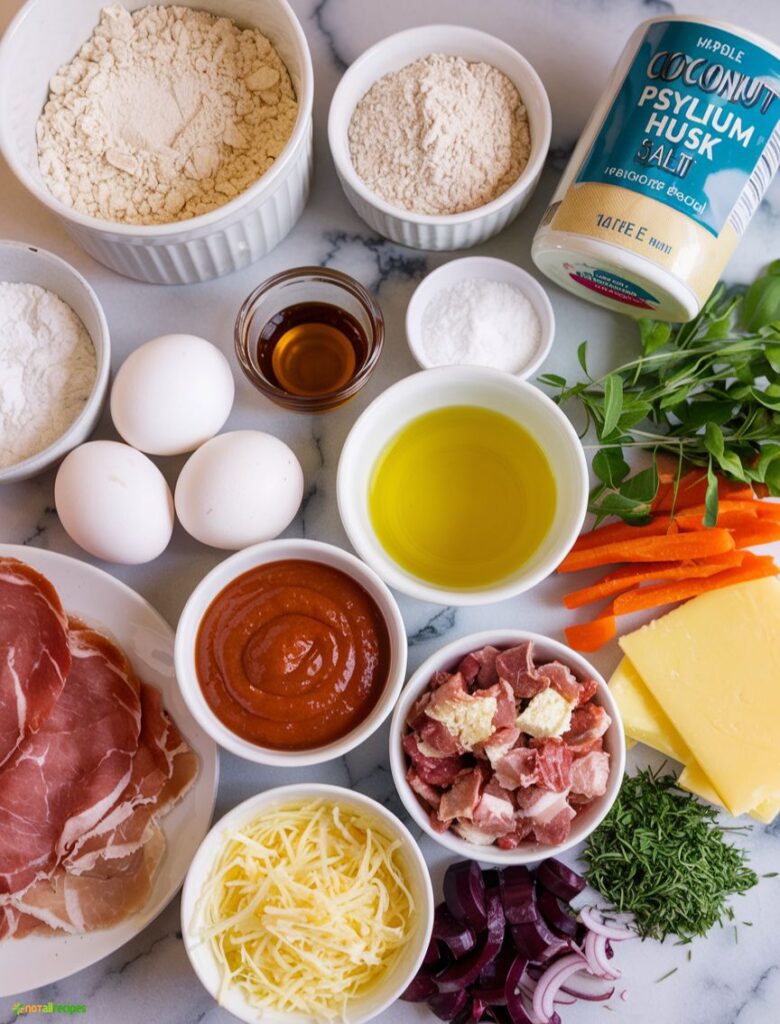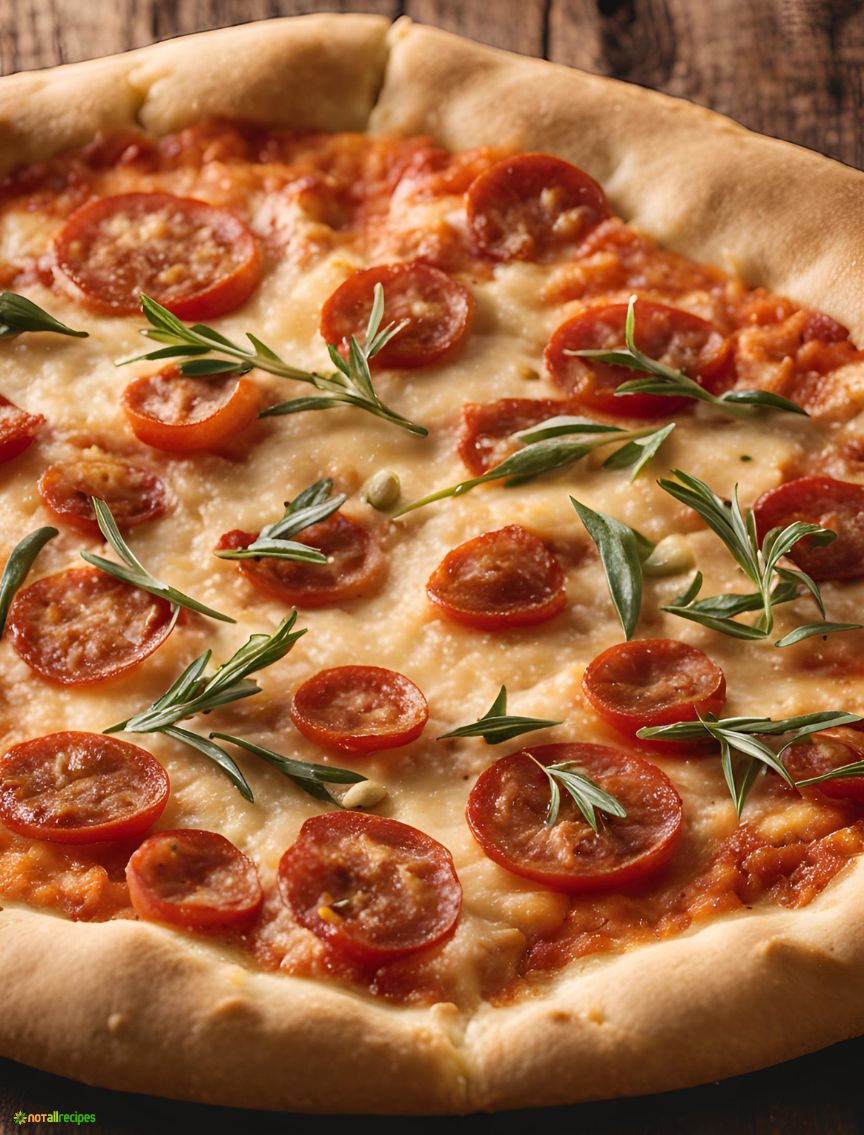The Best Gluten-Free Pizza Crust: Crispy, Chewy, and Totally Satisfying!
Let’s be honest, finding the best gluten-free pizza crust can feel like searching for a needle in a haystack. Most gluten-free pizzas are either too dry, too crumbly, or just don’t have that same chewiness and crispiness we all crave. But not anymore! This gluten-free pizza crust is the game-changer you’ve been waiting for. Whether you’re celiac, gluten intolerant, or just trying to eat fewer grains, this crust brings that perfect balance of crispy edges and a chewy center.
And here’s the best part—it’s not only gluten-free, but also grain-free, dairy-free, and made with simple, whole ingredients. It’s easy to prepare, and you can top it with all your favorite pizza ingredients without worrying about the dough falling apart. Whether you love classic Margherita or go wild with veggies, this recipe has you covered! 🍕
Want to master gluten-free baking? Be sure to check out our guide to Top Gluten-Free Baking Tips: From Crumbly to Delicious! for foolproof techniques.
Why Make Gluten-Free Pizza Crust?

If you’ve ever had trouble finding a good store-bought gluten-free pizza crust, you’re not alone. Store-bought options can be expensive, often filled with unnecessary preservatives and refined sugars. Making your own gluten-free pizza dough from scratch is not only healthier, but also super easy and fun. Plus, you can control the ingredients and make sure everything aligns with your dietary needs.
Another bonus? This recipe is grain-free! That’s right—you don’t have to rely on rice or other grains, which is perfect if you’re following a paleo or grain-free diet. You’ll also be using wholesome, nutrient-dense ingredients like almond flour, tapioca starch, and coconut flour. The result? A delicious, homemade pizza crust that you’ll want to eat every week. 🍕
Ready to make more gluten-free dishes? Check out our Best Classic Cheesecake Recipe: Rich & Creamy—you’ll love how it pairs with your pizza night!
Key Ingredients for the Best Gluten-Free Pizza Crust

Before we get started, let’s go over the essential ingredients that make this pizza crust crispy, chewy, and absolutely perfect.
- Almond Flour: Adds richness and healthy fats while keeping the crust gluten-free and grain-free.
- Tapioca Starch: This helps give the crust its signature chewiness and also makes it flexible enough to roll out.
- Coconut Flour: Absorbs moisture and helps bind the ingredients together without grains.
- Eggs: Acts as the binder, providing structure and ensuring the crust holds together.
- Olive Oil: Enhances the flavor while giving the crust a crispy, golden edge.
- Apple Cider Vinegar: Reacts with the baking soda to help the dough rise and stay fluffy.
- Salt and Herbs: To season the dough with a classic Italian taste.
For more on baking with these flours, here’s a deep dive into gluten-free flours to get you started.
Step-by-Step Guide: How to Make The Best Gluten-Free Pizza Crust
Step 1: Mix Your Dry Ingredients
In a large bowl, combine almond flour, tapioca starch, coconut flour, baking soda, and salt. You can also add in dried herbs like oregano or basil to give your crust more flavor. For more baking tips, visit our Top Gluten-Free Baking Tips guide to learn how to balance gluten-free ingredients.
Step 2: Add the Wet Ingredients
Whisk together your eggs, apple cider vinegar, and olive oil in a separate bowl. Slowly mix the wet ingredients into the dry until a dough forms. If the dough seems too sticky, add a little more tapioca starch.
Step 3: Roll Out the Dough
Place the dough between two sheets of parchment paper and roll it out into your desired pizza shape. A pro tip here: Don’t make the crust too thick. A thinner crust will bake up crispier and more evenly.
Step 4: Pre-Bake the Crust
Preheat your oven to 425°F (220°C). Slide the rolled-out dough (with parchment paper) onto a pizza stone or baking sheet. Bake the crust for 10-12 minutes, until it’s just starting to turn golden.
Step 5: Add Your Toppings
Now comes the fun part—adding toppings! Whether you’re a fan of classic marinara sauce and mozzarella, or you’re loading up with veggies and dairy-free cheese, go wild!
Need some inspiration for gluten-free pizza toppings? Explore these creative ideas in this BBC Good Food article to make your pizza even more delicious!
Step 6: Final Bake
After adding your toppings, put the pizza back in the oven for another 10-15 minutes, until the edges are crispy and the cheese (or dairy-free alternative) is bubbling.
The Best Gluten-Free Pizza Crust Tips for Success
- Avoid Over-Mixing: Be gentle with the dough, as over-mixing can make it too tough or dry.
- Use Parchment Paper: Rolling out the dough between parchment paper makes it much easier to transfer to your baking sheet.
- Experiment with Flours: Feel free to experiment with other gluten-free flours, like cassava flour or arrowroot starch, to see what texture you prefer. Learn more about gluten-free flours here.
Nutrition Information (Per Serving)

| Nutrient | Amount |
|---|---|
| Calories | 250 kcal |
| Carbohydrates | 18g |
| Fat | 16g |
| Protein | 8g |
| Fiber | 4g |
| Sugar | 1g |
Pro Tip: For a lower-carb version, you can substitute almond flour with a mix of coconut flour and flaxseed meal. This will reduce the carb count and boost the fiber content, keeping you fuller for longer.
Storage Tips: How to Freeze and Reheat Your Gluten-Free Pizza Crust
One of the best things about this gluten-free pizza crust is that it freezes beautifully! You can make a big batch of crusts, pre-bake them, and store them in the freezer for up to 3 months.
- To Freeze: Pre-bake the crust, let it cool completely, then wrap tightly in plastic wrap and place in a freezer-safe bag.
- To Reheat: When you’re ready to eat, just thaw the crust in the fridge and bake it for 5-7 minutes at 425°F before adding toppings and finishing.
For more freezing tips, check out our full guide on How to Freeze Desserts Like a Pro.
Cost Breakdown (Per Serving)
Here’s an estimate of the cost per serving for this gluten-free pizza crust recipe:
| Ingredient | Cost |
|---|---|
| Almond Flour | $1.50 |
| Tapioca Starch | $0.30 |
| Coconut Flour | $0.25 |
| Eggs | $0.40 |
| Olive Oil | $0.20 |
| Apple Cider Vinegar | $0.10 |
| Herbs & Spices | $0.05 |
| Total Cost | $2.80 |
While this crust might cost a bit more than a traditional pizza crust, the nutrient density and satisfaction of a homemade, healthy, gluten-free pizza make it absolutely worth it!
If you’re curious about the nutritional profiles of the flours used, you can check out this article for an in-depth comparison of almond flour and coconut flour.
Final Thoughts: Why You’ll Love This Gluten-Free Pizza Crust
In a world full of gluten-filled pizza options, it’s refreshing to have a delicious and simple gluten-free crust that everyone can enjoy. This recipe will be your new go-to for pizza nights, whether you’re gluten intolerant or just looking for a healthier, grain-free alternative. It’s quick to make, easy to freeze, and absolutely delicious with any topping you choose.
So go ahead, give this recipe a try and enjoy pizza night without any gluten worries! And don’t forget to check out our Best Classic Cheesecake Recipe: Rich & Creamy for the perfect dessert to follow your pizza feast.
The Recap Of The Recipe

The Best Gluten-Free Pizza Crust
Equipment
- Mixing bowl For combining the dry and wet ingredients.
- Whisk or Fork To thoroughly mix the dry ingredients and ensure an even consistency.
- Measuring Cups and Spoons For accurate measurements of all ingredients.
- Parchment Paper To line your baking sheet or pizza stone, preventing sticking.
- Baking Sheet or Pizza Stone To bake the pizza crust; a pizza stone will provide a crispier crust.
- Rolling Pin (optional) For rolling out the dough to your desired thickness.
- Spatula or Offset Spatula For spreading the dough evenly on the baking surface.
Ingredients
- Almond Flour: Adds richness and healthy fats while keeping the crust gluten-free and grain-free.
- Tapioca Starch: This helps give the crust its signature chewiness and also makes it flexible enough to roll out.
- Coconut Flour: Absorbs moisture and helps bind the ingredients together without grains.
- Eggs: Acts as the binder providing structure and ensuring the crust holds together.
- Olive Oil: Enhances the flavor while giving the crust a crispy golden edge.
- Apple Cider Vinegar: Reacts with the baking soda to help the dough rise and stay fluffy.
- Salt and Herbs: To season the dough with a classic Italian taste.
- For more on baking with these flours here’s a deep dive into gluten-free flours to get you started.
Instructions
- Step 1: Mix Your Dry Ingredients
- In a large bowl, combine almond flour, tapioca starch, coconut flour, baking soda, and salt. You can also add in dried herbs like oregano or basil to give your crust more flavor. For more baking tips, visit our Top Gluten-Free Baking Tips guide to learn how to balance gluten-free ingredients.
- Step 2: Add the Wet Ingredients
- Whisk together your eggs, apple cider vinegar, and olive oil in a separate bowl. Slowly mix the wet ingredients into the dry until a dough forms. If the dough seems too sticky, add a little more tapioca starch.
- Step 3: Roll Out the Dough
- Place the dough between two sheets of parchment paper and roll it out into your desired pizza shape. A pro tip here: Don’t make the crust too thick. A thinner crust will bake up crispier and more evenly.
- Step 4: Pre-Bake the Crust
- Preheat your oven to 425°F (220°C). Slide the rolled-out dough (with parchment paper) onto a pizza stone or baking sheet. Bake the crust for 10-12 minutes, until it’s just starting to turn golden.
- Step 5: Add Your Toppings
- Now comes the fun part—adding toppings! Whether you’re a fan of classic marinara sauce and mozzarella, or you’re loading up with veggies and dairy-free cheese, go wild!
- Need topping ideas? Cream Cheese: 15 Creative Ways to Use It Beyond Bagels offers some unique options to spice up your pizza.
- Step 6: Final Bake
- After adding your toppings, put the pizza back in the oven for another 10-15 minutes, until the edges are crispy and the cheese (or dairy-free alternative) is bubbling.
Notes
- Storage: Leftover pizza crust can be stored in an airtight container in the refrigerator for up to 3 days. To reheat, place it in the oven at 350°F (175°C) for about 10 minutes.
- Freezing: This crust can be frozen! After baking, allow it to cool completely, then wrap it tightly in plastic wrap and foil. It can be stored in the freezer for up to 3 months. When ready to use, thaw it in the refrigerator overnight before adding toppings and reheating.
- Topping Suggestions: Feel free to get creative with your toppings! This crust pairs well with tomato sauce, cheese, vegetables, and proteins. Try different combinations like BBQ chicken, margherita, or a classic pepperoni.
- Adjustments: If you’re sensitive to nuts, you can substitute almond flour with sunflower seed flour for a nut-free version.
- Baking Time: Keep an eye on the crust while baking; oven temperatures can vary. You want it to be golden brown but not overly crisp.
- Make it Dairy-Free: To make this pizza crust dairy-free, use dairy-free cheese or simply top it with fresh vegetables and herbs.

